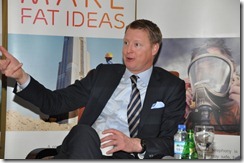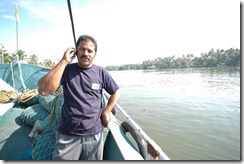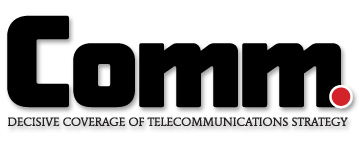Ericsson continues to dominate the global telecom infrastructure market, though its performance in 2012 highlighted some weaknesses that the company is looking to improve. President and CEO Hans Vestberg articulates the company’s future plans and direction 
Hans Vestberg believes the further investment in LTE infrastructure in 2013 shall boost Ericsson’s prospects even further during the course of the year
In the middle of last year, media reports were awash that Huawei’s first half performance was set to see the Chinese technology provider overtake Ericsson as the world’s largest telecom technology company on an overall revenue basis. Huawei went on to report a 5.1 per cent rise in sales to RMB102.7 billion (US$16.1 billion) for first-half 2012, ended June 30, which surpassed Ericsson’s SEK106.3 billion (US$15.25 billion) over the same period.
Full-year results turned out to be a little different, with Ericsson nudging ahead with annual revenue equivalent to US$36 billion, and Huawei not far behind at US$35.43 billion, to allow Ericsson to retain its ‘largest telecom technology company in the world’ title. However, what has become clear is that the position at the top of the sector has become fiercely challenged, and Ericsson will have to be at its very best in order to stave off the following pack of competitors, Huawei being first amongst them.
In a similar vein to its primary competitor, Ericsson is placing increased emphasis on the enterprise market as it sees significant scope for growth in this area. The company recently announced that in an effort to meet the growing demand for machine-to-machine technology, in cooperation with SAP the y would jointly market and sell cloud-based, machine-to-machine (M2M) solutions and services to enterprises via operators around the globe. The solutions will be based on a combined software-as-a-service (SaaS) offering from Ericsson and SAP within M2M.
It is hoped the combined power of Ericsson’s services, solutions, technology and network operator infrastructure, combined with enterprise business solutions from SAP will allow businesses to find better and more innovative ways to respond to customer needs even more quickly than they could before.
Ericsson believes that enterprises have faced barriers to the adoption of M2M solutions, including a lack of complete multi-industry, end-to-end offerings and deficiency of suitable global coverage connectivity solutions that are needed by multinational enterprises. Ericsson and SAP are teaming up to deliver a connected cloud-based offering to operators that will remove those barriers, while at the same time adding the benefits of minimal up-front investment and faster time-to-market. These new solutions and services are also set to help enhance enterprise efficiency in key business processes such as maintenance, remote service, inventory, logistics and road transport management, vending and customer experience management.
SAP is well positioned to offer enterprises market leading mobile, cloud computing and big data analytics, as well as in-depth experience in combining those technologies to create unique and powerful solutions across 24 industries.
In addition to solutions and technology, Ericsson will lend its consulting, systems integration and managed services, and complementary device and applications testing, as well as verification services to facilitate a faster time-to-market, efficient use of mobile network resources and an optimised user experience. Operators, such as M2M connectivity providers, may choose from different levels of ambition, ranging from a full enterprise M2M prime supplier to an ecosystem partner.
Ericsson says the M2M opportunity remains a significant one despite network operators not having generated much incremental revenue from it thus far
Ericsson has been one of the biggest proponents of the ‘connected world’ vision and the significant revenue-generating opportunity that exists in the realm of M2M services. There are over one billion mobile broadband subscribers in the world, with the number of global mobile subscribers expected to climb to nine billion by 2016. A year earlier in 2015, Ericsson forecasts that as many as 50 billion connected devices will be in use, with the view being that machines that benefit from a connection to some network shall increasing be so.
“Ericsson’s enterprise focus runs into our overall vision of the Network Society,” said Hans Vestberg, president and CEO of Ericsson. "The global M2M service revenue is estimated to reach more than US$200 billion by 2017. This partnership (with SAP) gives us a chance to unlock some of that potential. By accessing services and controlling devices with solutions leveraging Ericsson experience from the communications industry and SAP from the enterprise segment, businesses will find better and more innovative ways to respond to customer needs more quickly.”
Aside from the tie-up with SAP, Ericsson continues to place a large amount of significance on its OSS/BSS operations, believing the continued growth in digital services will make this area crucial for network operators’ future success.
“Mobile broadband, OSS/BSS, and managed services are all growth areas and areas in which Ericsson is number one. We are looking to maintain and strengthen our number one position in these areas,” Vestberg said.
Vestberg estimates that 50 per cent of LTE traffic around the world is going over Ericsson networks, and the company intends to consolidate the gains it made in the technology last year in 2013 and beyond.
According to Technology Business Research, capex budget guidance indicates North America-based operators will continue spending aggressively on LTE equipment in 2013, enabling Ericsson to once again claim LTE leadership. The Sprint Network Vision will continue to ramp up, benefitting Ericsson, Alcatel-Lucent and Samsung. Latin America will also fuel Ericsson’s LTE revenues as the vendor secured more than 50 per cent market share in the region for LTE deployments, locking in contracts with Une, Oi, Vivo, Telcel, Claro and TIM Brasil.
Huawei, Alcatel-Lucent and ZTE will see their LTE fortunes rise in 2013 as China Mobile, the largest operator in the world by subscriber count, deploys TD-LTE. The operator plans to deploy 200,000 TD-LTE base stations in 2013 in a bid to jumpstart its 4G network, and these three vendors are likely to land the highest shares of the contract. Huawei and ZTE will benefit from select LTE rollouts in Europe, where China-based vendors will be aggressive on price to supplant NSN and Alcatel-Lucent from existing accounts.
Managed services continues to be a strong activity for Ericsson, with the technology provider announcing in February that India’s number-three operator Reliance Communications (RCom) had awarded it an eight-year managed services contract worth US$1 billion.
The agreement will see Ericsson support wireless and fixed networks in north and west India, covering Delhi and Mumbai and a total of 11 telecom circles.
Ericsson will manage day-to-day operations and will be responsible for the maintenance and operational planning of RCom’s 2G, CDMA and 3G mobile networks.
Around 5,000 RCom employees will move to Ericsson as part of the agreement.
In February, Ericsson was awarded a US$1 billion managed services contract by Reliance Communications in India – Source GSMA & Decisive Media
The integrated management provided by Ericsson should bring customer experience improvements, operational efficiencies and cost optimisation, and free up resources for RCom to focus on user experience and innovation.
Further, Ericsson forecasts that 50 per cent of all mobile phones shipped in the fourth quarter of 2013 will be smartphones, in line with the significant growth in digital services that is expected.
“We expect there to be two billion mobile broadband subscribers by the end of 2013, and a development of tiered, shared, bundled, and real-time pricing models,” Vestberg said.
Daily consumption of data per mobile subscriber is set to reach as high as 20MB by the end of 2013, with Ericsson also forecasting that 100 million LTE subscribers will be in place globally by the end of the year.





0 comments ↓
There are no comments yet...Kick things off by filling out the form below.
Leave a Comment